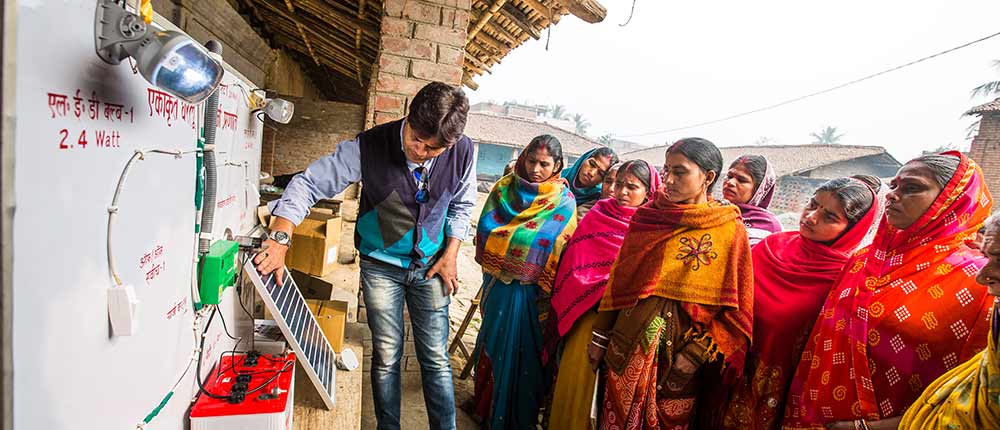Women in rural India are embracing clean energy-based livelihood technologies to help them grow their businesses. Distributed renewable energy (DRE) is transforming women’s livelihoods at the grassroots level, from solar refrigerators to silk-reeling machines and biomass-based cold storage to bulk milk chillers.

What is DRE (Distributed Renewable Energy)?
- DRE is the generation and distribution of electricity via small-scale, decentralised systems using renewable energy sources such as solar, wind, hydro, geothermal, and biomass.
- These systems are frequently installed in remote or rural areas where connecting to a centralised power grid is difficult or expensive.
- Individual rooftop solar panels to small-scale wind turbines, mini-hydro systems, and biomass generators are examples of DRE systems.
- Rather than a large urban or industrial centre, they are typically designed to serve a single household or community.
- DRE systems, also known as off-grid or mini-grid systems, can operate independently or in conjunction with a larger power grid.
Recent Figures
- Over 80% are female: According to a recent Council on Energy, Environment, and Water (CEEW) study, more than 80% of the 13,000 early adopters of clean tech livelihood appliances are women.
- Projection for the future: India is expected to have 30 million women-owned micro, small, and medium enterprises (MSMEs) employing approximately 150 million people by 2030. DRE livelihood technologies have the potential to transform rural livelihoods, with women at the forefront of this transition, with a $50 billion market opportunity in India alone.
DRE systems have several advantages
- Including being more resilient to natural disasters and grid failures, lowering energy costs for communities and households, and increasing energy access in areas not served by the main power grid.
- Reduce carbon emissions: DRE systems can also help to reduce carbon emissions and mitigate the effects of climate change.
- Women benefit from DRE in the following ways: DRE-powered technologies give women farmers and microentrepreneurs an added advantage by increasing income opportunities through mechanisation. They also liberate women from several laborious gender-assigned manual tasks.
Steps to scale up this impact
- Leverage the experience of early female adopters: Technology providers must encourage early adopters to share their experiences with potential customers, transforming them into demo champions/sales agents to market these products based on their first-hand product experience and local credibility.
- As an example: Kissan Dharmbir, a manufacturer of energy-efficient food processors, chose Neetu Tandan, an Agra-based microentrepreneur who uses the processor to make fruit squashes and jams, as a demo champion. Sales leads are being generated by her demonstrations.
- Organize hyperlocal events and demos: These events provide opportunities for women to network, learn about the product, and connect with people who can assist them in acquiring, financing, and using these machines.
- For example, more than 200 women booked seven appliances on the spot at an event in Hamirpur, Uttar Pradesh, including solar sewing machines and multi-purpose food processors.
- Allow for simple financing of product purchases: The limited financing options for these clean technology products continue to be a bottleneck. Financiers who assist women farmers and microentrepreneurs should consider the technologies themselves as collateral, while also making the loan application process easier.
- For example, Samunnati Finance, an agri-value chain financier, provided an 80% first-loan default guarantee to six women-led FPOs in Andhra Pradesh that purchased 100-kg solar dryers.
- Support for backward and forward market linkages: In some cases, simply providing technology is insufficient. Many rural products have a wider market. Finding and connecting producers to consumption hubs in urban areas is thus equally important for increasing income.
- Ensure adequate after-sales services and buybacks: Technology manufacturers and promoters must also provide adequate after-sales services and buybacks. To instill confidence in financiers, evidence of these technologies’ economic viability should be shared, and promoters should offer partial default guarantees.
- Enable policy convergence: Because no private sector entity has the reach and scale that government institutions do, leveraging their reach is critical to exponentially scaling up. State rural livelihood missions, horticulture and agriculture departments, the Ministry of Micro, Small and Medium Enterprises, and the Ministry of Textiles are all working to promote women’s livelihoods. They must embrace clean energy solutions in order to advance their respective programmes and outcomes.
What are the difficulties that women face?
- High risk perception: The high starting price and newness of DRE appliances can create a high risk perception, particularly among female users who may have a lower risk appetite due to socioeconomic factors.
- Low belief: Because women’s access to new information has historically been limited, people prefer to physically touch and see high-tech, high-priced DRE products before believing in their ability and promised benefits.
- Women frequently struggle with established market links due to their limited mobility and networks outside of their villages.
@the end
Scaling the impact of clean energy solutions on women’s livelihoods requires a village of policymakers, investors, financiers, technology promoters, and other ecosystem enablers, much like raising a child. Only then will we be able to truly unleash the potential of rural women and clean technologies at the same time.
Source: https://www.teriin.org/article/distributed-renewable-energy-transforms-womens-lives-rural-bihar
